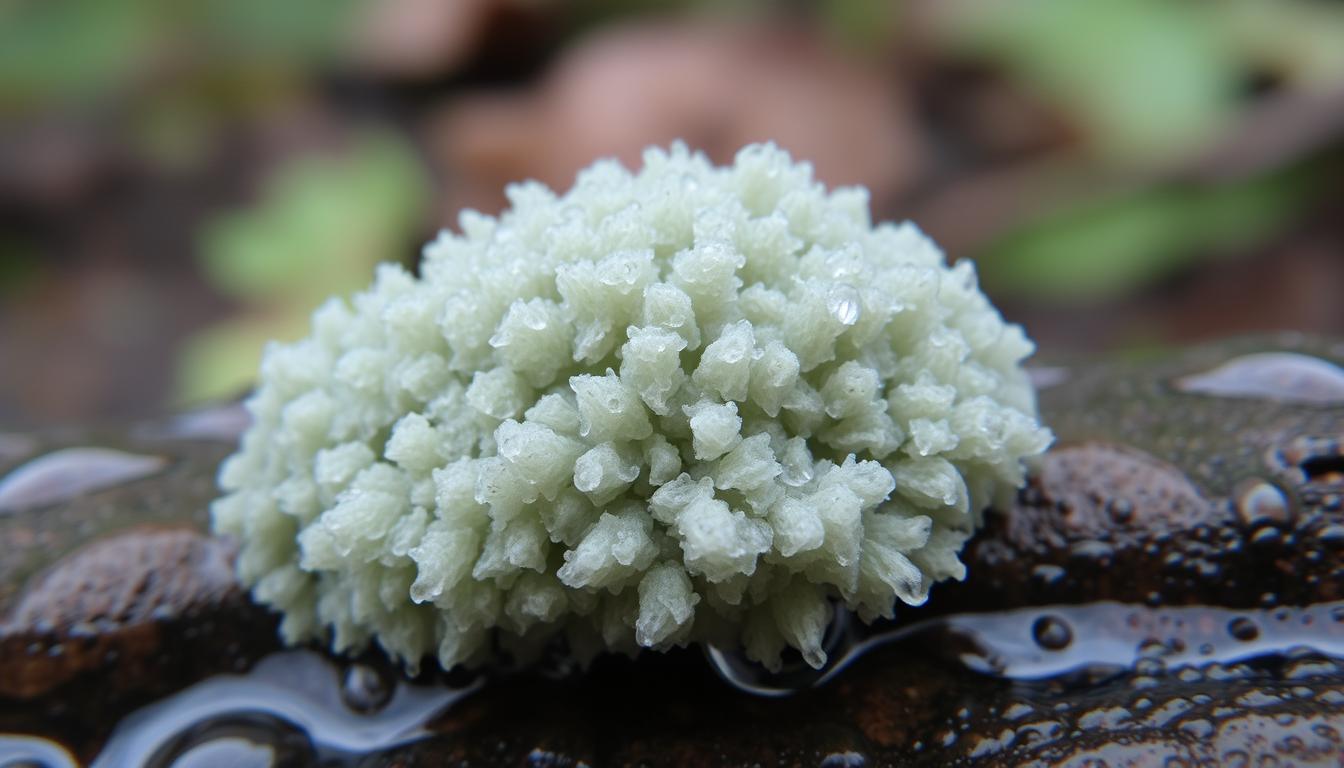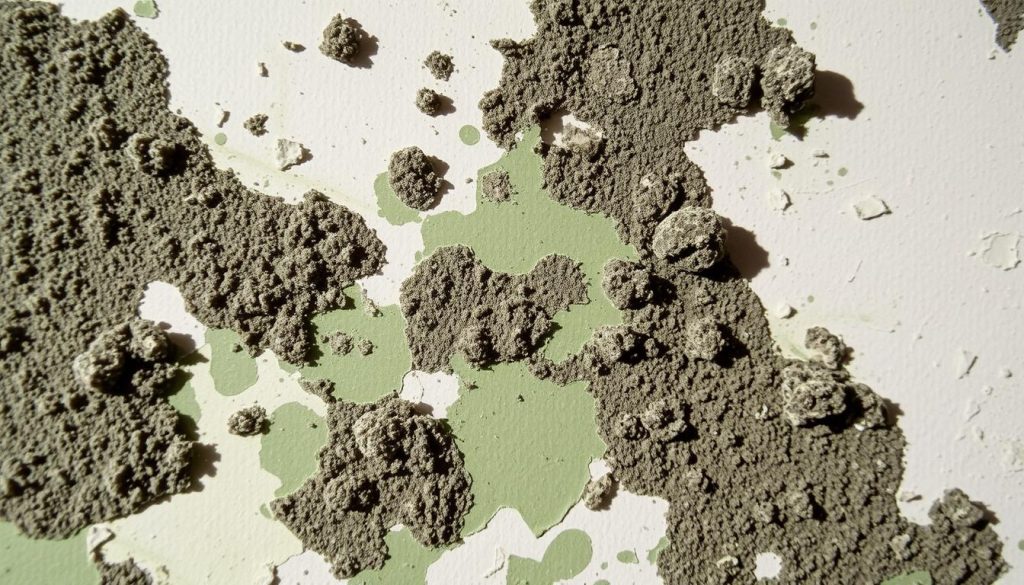
Florida’s humid climate creates perfect conditions for water mold growth in our homes and businesses. Spotting mold early is vital to protect our properties and health. Let’s explore how to identify these unwelcome guests.
Unusual wall marks or musty odors often signal mold growth. These signs may point to water damage or poor air circulation. Mold spores are everywhere, waiting for the right conditions to flourish.
Leaks, floods, and high humidity create ideal environments for mold. Different molds have unique colors and textures, from fuzzy to slimy. Black mold, for example, appears as dark green or black patches.
Identifying mold correctly is crucial for effective treatment. While black mold is notorious, other types pose risks too. Quick action is key to maintaining a healthy living space.
Common Types of Water Mold and Their Appearance
Water damage can lead to various types of mold growth in our homes. Each mold type has its own look and potential health risks. Learning about these molds helps us spot and handle problems quickly.
Stachybotrys Chartarum (Black Mold)
Black mold, or Stachybotrys chartarum, is a toxic mold with a slimy texture. It appears black or dark greenish-black in color. This mold thrives in damp areas with high humidity.
You might find it on wet walls, ceilings, and floors. Exposure can cause breathing issues, headaches, and dizziness. These problems stem from the toxins black mold produces.
Alternaria
Alternaria is a common allergen found in many homes. It’s dark brown or black with a velvety or wool-like texture. This mold often grows on moist surfaces like window frames and showers.
Breathing in Alternaria spores can trigger allergies and asthma. It’s especially common in warm, dry climates.
Cladosporium
Cladosporium is often mistaken for black mold due to its dark color. It ranges from olive green to black with a velvety texture. This mold can grow on walls, ceilings, carpets, and fabrics.
Exposure may cause breathing problems and allergic reactions. In some cases, it can even lead to infections.
Penicillium
Penicillium includes many species, often appearing green or blue. It has a fuzzy or powdery texture. This mold commonly grows on damp wallpaper, carpets, and fabrics.
Inhaling Penicillium spores can cause allergic reactions and sinus infections. It may also lead to lung inflammation, especially in people with breathing issues.
| Mold Type | Color | Texture | Health Risks |
|---|---|---|---|
| Stachybotrys Chartarum (Black Mold) | Black or dark greenish-black | Slimy | Respiratory issues, headaches, dizziness |
| Alternaria | Dark brown or black | Velvety or wool-like | Allergic reactions, asthma symptoms |
| Cladosporium | Dark olive green to black | Velvety or suede-like | Respiratory problems, allergic reactions, infections |
| Penicillium | Green or blue | Fuzzy or powdery | Allergic reactions, sinus infections, lung inflammation |
Knowing these mold types helps us spot potential growth in our homes. Regular checks and good airflow can prevent mold growth. Quick action on water damage also protects our health and property.
Signs of Water Damage Mold
Water damage mold can appear in many ways. It often hints at bigger problems hidden from view. Knowing these signs helps homeowners fix issues fast and prevent further damage.
Discoloration on Surfaces
Discoloration is a clear sign of water damage mold. It can show up on walls, ceilings, floors, and furniture. These stains might be black, green, brown, or white, depending on the mold type.
Check damp areas for unusual colors. If you spot any, it’s time to take a closer look.
Musty Odors
A lasting musty smell often means mold is growing. This damp, earthy scent can linger even if you can’t see mold. It might be hiding behind walls or under floors.

Peeling Paint or Wallpaper
Moisture can make paint or wallpaper bubble, peel, or crack. This can happen for other reasons too, like age or poor application. But when paired with odd smells or colors, it might mean water damage mold.
Warped Wood
Wood affected by water damage often swells or feels soft. Look for changes in baseboards, door frames, and window sills. Any weird textures or looks in wooden parts could mean trouble.
Visible Mold Growth
The clearest sign is seeing mold on surfaces. It can look fuzzy or slimy. Mold comes in many colors like black, green, gray, or white.
If you see any mold, act fast to stop it from spreading.
| Sign of Water Damage Mold | Description |
|---|---|
| Discoloration on Surfaces | Stains in various colors (black, green, brown, white) on walls, ceilings, floors, and upholstery |
| Musty Odors | Persistent damp, earthy, or stale smell, even without visible mold growth |
| Peeling Paint or Wallpaper | Bubbling, peeling, or cracking of paint or wallpaper due to moisture seepage |
| Warped Wood | Swelling, warping, or softening of wooden elements like baseboards, door frames, and window sills |
| Visible Mold Growth | Fuzzy or slimy growth in various colors (black, green, gray, white) on surfaces |
“If you smell moldy odors in every room, having your home’s ductwork inspected by a restoration professional is recommended.”
Stay alert for water damage mold signs. Quick action can save you from big repairs. If you think you have mold, call a certified expert right away.
What Does Water Mold Look Like?
Water mold isn’t always easy to spot. It often starts as a slimy biofilm, indicating bacteria and mold buildup. Look for fuzzy or slimy patches in green, black, or white shades. These spots can vary in size and may have a musty smell.
Cloudy or murky water can signal mold presence. Check for haziness or strange colors in your bottle. Mold may leave a residue on the bottle’s walls. An unusual taste could also indicate mold contamination.
Mold comes in various colors, not just black and green. It can be white, orange, yellow, brown, purple, or pink. Regular bottle inspections help catch mold growth early. This way, you can take action to protect your health.







